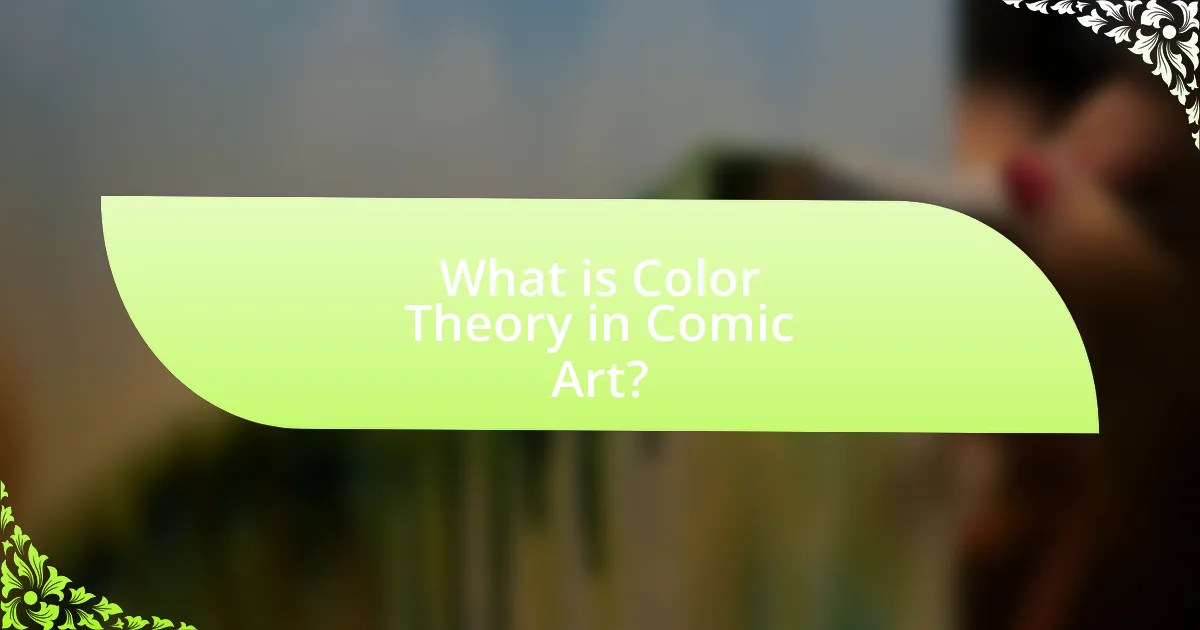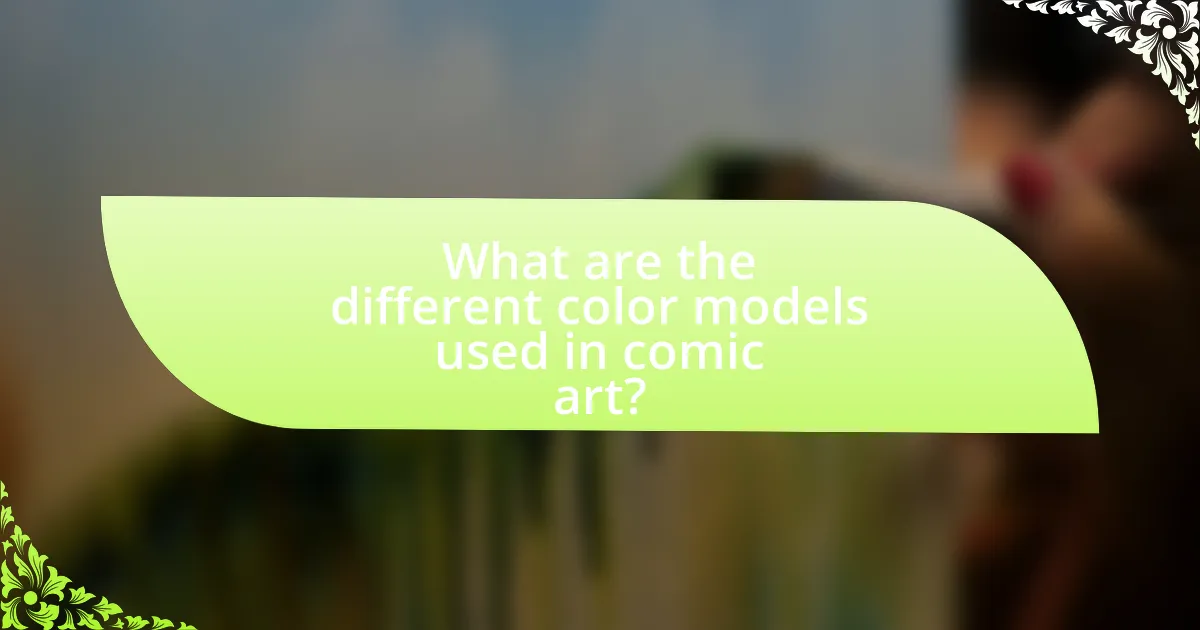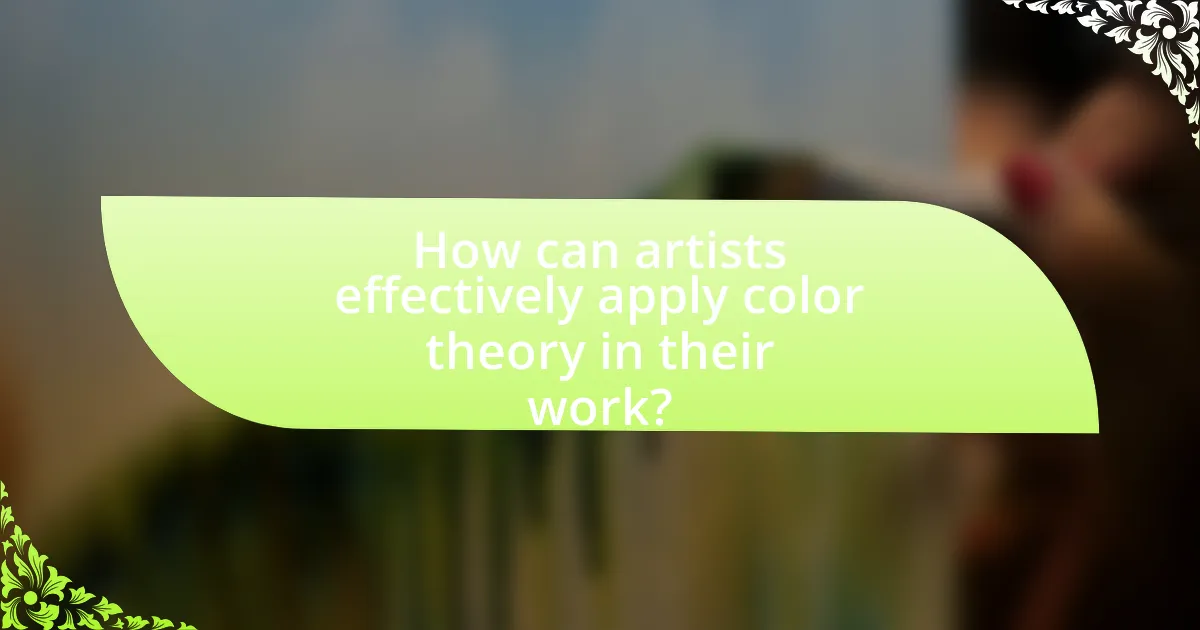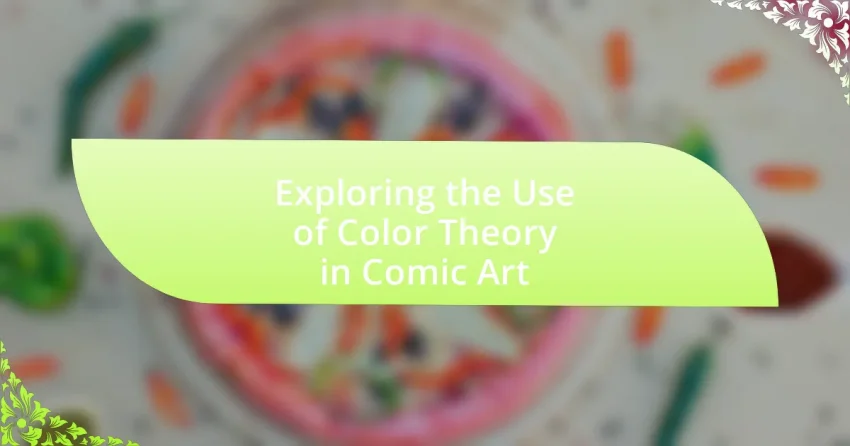Color theory in comic art encompasses the principles and guidelines that govern the use of color to create visual harmony, convey emotions, and enhance storytelling. The article explores how color influences visual storytelling by guiding emotional responses, establishing mood, and affecting pacing. It discusses fundamental principles such as the color wheel, color harmony, and contrast, as well as the psychological effects of colors on readers. Additionally, the article highlights the importance of color selection in character emotions and narrative clarity, while providing practical tips and resources for artists to effectively apply color theory in their work.

What is Color Theory in Comic Art?
Color theory in comic art refers to the principles and guidelines that govern the use of color to create visual harmony, convey emotions, and enhance storytelling. This theory encompasses concepts such as color wheel relationships, color harmony, and the psychological effects of colors, which artists utilize to evoke specific feelings and reactions from the audience. For instance, complementary colors can create contrast and draw attention, while analogous colors can provide a sense of unity. The application of color theory in comic art is essential for effective visual communication, as it influences how readers perceive characters, settings, and moods throughout the narrative.
How does color theory influence the visual storytelling in comics?
Color theory significantly influences visual storytelling in comics by guiding emotional responses and enhancing narrative clarity. The use of color can evoke specific feelings; for instance, warm colors like red and orange can create a sense of urgency or passion, while cool colors like blue and green can convey calmness or sadness. This emotional resonance helps readers connect with characters and situations more deeply.
Additionally, color theory aids in establishing mood and atmosphere, as seen in works like “Watchmen,” where muted tones reflect a grim narrative, contrasting with vibrant colors that signify hope or action. Furthermore, color can delineate different story arcs or timelines, providing visual cues that enhance comprehension. Research indicates that color choices can affect memory retention and engagement, making them crucial for effective storytelling in comics.
What are the fundamental principles of color theory relevant to comic art?
The fundamental principles of color theory relevant to comic art include the color wheel, color harmony, contrast, and the psychological effects of color. The color wheel serves as a visual representation of colors and their relationships, helping artists choose complementary or analogous colors to create visual interest. Color harmony involves the use of color combinations that are aesthetically pleasing, such as triadic or tetradic schemes, which enhance the overall composition of comic panels. Contrast, particularly between light and dark colors, is crucial for emphasizing characters and actions, guiding the viewer’s eye through the narrative. Additionally, the psychological effects of color influence audience perception; for example, red can evoke excitement or danger, while blue may convey calmness or sadness. These principles are essential for effective storytelling and visual impact in comic art.
How do color harmonies enhance character emotions in comics?
Color harmonies enhance character emotions in comics by creating visual relationships that evoke specific feelings and moods. For instance, complementary colors can generate tension or conflict, while analogous colors often convey harmony and tranquility. Research in color psychology indicates that colors can influence emotional responses; for example, warm colors like red and orange can evoke excitement or anger, while cool colors like blue and green can induce calmness or sadness. This strategic use of color harmonies allows artists to visually communicate a character’s emotional state, guiding the reader’s emotional experience and interpretation of the narrative.
Why is color selection important in comic art?
Color selection is crucial in comic art because it influences the emotional tone, guides the reader’s focus, and enhances storytelling. The use of specific colors can evoke feelings such as happiness, sadness, or tension, thereby affecting the reader’s emotional response to the narrative. For instance, warm colors like red and yellow can create a sense of urgency or excitement, while cool colors like blue and green can convey calmness or melancholy. Additionally, color can direct attention to key elements within a panel, helping to establish hierarchy and flow in the visual storytelling. Studies in color theory, such as those by Johannes Itten, demonstrate that color combinations can significantly impact perception and mood, reinforcing the importance of thoughtful color selection in comic art.
What psychological effects do colors have on readers?
Colors significantly influence readers’ emotions and perceptions, impacting their engagement and interpretation of content. For instance, warm colors like red and orange can evoke feelings of excitement or urgency, while cool colors such as blue and green often promote calmness and tranquility. Research by Andrew Elliot and Markus Maier in their study “Color and Psychological Functioning: A Review of Theoretical and Empirical Work” published in 2014 indicates that colors can affect cognitive performance and emotional responses, demonstrating that color choices in comic art can enhance storytelling by aligning visual elements with the intended emotional tone.
How can color choices affect the pacing and mood of a comic?
Color choices significantly influence the pacing and mood of a comic by guiding the reader’s emotional response and controlling the visual tempo. For instance, warm colors like red and orange can create a sense of urgency or excitement, accelerating the perceived pacing, while cool colors such as blue and green can evoke calmness or sadness, slowing down the reader’s engagement. Research indicates that color can affect emotional perception; a study published in the journal “Color Research and Application” found that colors can elicit specific emotional responses, which directly impacts how readers interpret scenes and narratives in comics. Thus, strategic color use not only enhances storytelling but also shapes the overall experience of the comic.

What are the different color models used in comic art?
The different color models used in comic art include RGB, CMYK, and HSL. RGB (Red, Green, Blue) is primarily used for digital comics, as it is based on light and is suitable for screens. CMYK (Cyan, Magenta, Yellow, Black) is utilized in print comics, as it corresponds to the ink colors used in printing processes. HSL (Hue, Saturation, Lightness) is often employed for color manipulation and design, allowing artists to adjust colors based on their attributes. These models are essential for achieving the desired visual effects and ensuring consistency across various media.
How do RGB and CMYK color models differ in application?
RGB and CMYK color models differ primarily in their application based on the medium of output. RGB (Red, Green, Blue) is an additive color model used for digital displays, where colors are created by combining light in varying intensities, making it ideal for screens and digital art. In contrast, CMYK (Cyan, Magenta, Yellow, Key/Black) is a subtractive color model used in color printing, where colors are produced by subtracting varying percentages of light absorbed by inks on paper. This fundamental difference in how colors are generated leads to RGB being preferred for digital illustrations and animations, while CMYK is essential for printed materials, ensuring accurate color reproduction in physical formats.
What are the advantages of using RGB for digital comics?
The advantages of using RGB for digital comics include a wider color gamut and enhanced vibrancy. RGB, which stands for Red, Green, and Blue, allows for the creation of millions of colors by combining these three primary colors in various intensities. This capability enables artists to achieve more vivid and dynamic visuals, which are essential for engaging storytelling in comics. Additionally, RGB is the standard color model for digital displays, ensuring that colors appear consistently across different devices, such as tablets and monitors. This consistency is crucial for maintaining the artistic vision of the comic across various platforms.
Why is CMYK preferred for printed comic books?
CMYK is preferred for printed comic books because it is specifically designed for color printing, utilizing four ink colors—cyan, magenta, yellow, and black—to create a wide range of hues and shades. This color model allows for more accurate color reproduction on paper, which is essential for the vibrant and detailed artwork typical in comic books. Additionally, the CMYK process is compatible with most printing presses, ensuring consistency and quality across large print runs. The use of CMYK also helps in achieving deeper blacks and better contrast, enhancing the visual impact of the comic art.
What role does color contrast play in comic art?
Color contrast plays a crucial role in comic art by enhancing visual clarity and guiding the reader’s attention. High contrast between colors helps distinguish characters, objects, and backgrounds, making the narrative easier to follow. For instance, the use of complementary colors can create dynamic scenes that draw the eye, while analogous colors can establish mood and atmosphere. Studies in visual perception indicate that contrast affects readability; a well-contrasted comic page can improve comprehension and engagement, as seen in works by artists like Frank Miller and Scott McCloud, who utilize color contrast strategically to convey emotion and action.
How can contrast be used to draw attention to key elements?
Contrast can be used to draw attention to key elements by creating visual differentiation between those elements and their surroundings. In comic art, high contrast between colors, such as pairing light and dark shades, emphasizes important characters or actions, making them stand out to the viewer. For example, using a bright color for a superhero against a muted background not only highlights the character but also guides the reader’s focus to the narrative’s focal point. This technique is supported by color theory principles, which indicate that contrasting colors can evoke emotional responses and enhance visual hierarchy, thereby reinforcing the significance of the highlighted elements in the artwork.
What are the best practices for achieving effective contrast in panels?
To achieve effective contrast in panels, utilize a combination of color theory principles, such as complementary colors, value contrast, and saturation differences. Complementary colors, which are opposite each other on the color wheel, create strong visual contrast that draws attention to key elements. For instance, pairing blue with orange enhances the vibrancy of both colors, making them stand out.
Additionally, employing value contrast—using light and dark shades—can significantly impact readability and focus within a panel. A light character against a dark background, or vice versa, ensures that the main subject is easily distinguishable. Furthermore, varying saturation levels can also enhance contrast; more saturated colors can be used to highlight important features, while muted tones can recede into the background.
Research in visual perception supports these practices, indicating that high contrast improves legibility and viewer engagement. For example, studies show that images with effective contrast are processed faster by the brain, leading to better comprehension and retention of visual information.

How can artists effectively apply color theory in their work?
Artists can effectively apply color theory in their work by understanding and utilizing the relationships between colors to evoke emotions and enhance storytelling. For instance, artists can use complementary colors to create contrast and draw attention to focal points, while analogous colors can establish harmony and cohesion within a piece. Research indicates that color choices can significantly influence viewer perception and emotional response, as demonstrated in studies like “The Impact of Color on Marketing” by Satyendra Singh, which found that color increases brand recognition by up to 80%. By strategically applying these principles, artists can enhance the visual impact of their comic art and communicate their narratives more effectively.
What techniques can artists use to create a cohesive color palette?
Artists can create a cohesive color palette by utilizing techniques such as color harmony, limited color schemes, and the use of color theory principles like complementary and analogous colors. Color harmony involves selecting colors that work well together, creating a visually pleasing effect. Limited color schemes restrict the number of colors used, which can enhance unity and focus within the artwork. Additionally, applying color theory principles, such as using complementary colors to create contrast or analogous colors for a more subtle transition, helps maintain a consistent visual language throughout the piece. These techniques are supported by the foundational concepts of color theory, which emphasize the relationships between colors and their psychological impacts on viewers.
How can color wheels assist in selecting complementary colors?
Color wheels assist in selecting complementary colors by visually representing the relationships between colors, specifically identifying pairs that enhance each other when used together. Complementary colors are located directly opposite each other on the color wheel, such as blue and orange or red and green. This arrangement allows artists and designers to easily find contrasting colors that create visual interest and balance in their work. The effectiveness of this method is supported by color theory, which states that complementary colors can intensify each other, making them appear more vibrant when placed side by side.
What are some common mistakes to avoid when choosing colors?
Common mistakes to avoid when choosing colors include relying solely on personal preference, neglecting color harmony, and ignoring the psychological effects of colors. Relying on personal preference can lead to choices that do not resonate with the intended audience or context. Neglecting color harmony may result in clashing colors that detract from the overall aesthetic, as established by color theory principles such as complementary and analogous color schemes. Ignoring the psychological effects of colors can undermine the emotional impact of the artwork; for instance, blue often conveys calmness, while red can evoke excitement or urgency. These mistakes can significantly affect the effectiveness of comic art, making it crucial to consider these factors in the color selection process.
What tools and resources are available for mastering color theory in comic art?
To master color theory in comic art, artists can utilize a variety of tools and resources including color wheel applications, online courses, and instructional books. Color wheel applications, such as Adobe Color and Coolors, help artists understand color relationships and create harmonious palettes. Online courses from platforms like Skillshare and Udemy offer structured learning on color theory specifically tailored for comic art. Additionally, books like “Color and Light: A Guide for the Realist Painter” by James Gurney provide in-depth knowledge and practical exercises. These resources collectively enhance an artist’s understanding and application of color theory in their comic art.
Which software programs are best for experimenting with color theory?
The best software programs for experimenting with color theory include Adobe Color, Procreate, and Corel Painter. Adobe Color allows users to create color schemes and explore color harmonies, making it a valuable tool for artists. Procreate offers a versatile color palette and blending options, enabling artists to experiment with colors directly on their digital canvases. Corel Painter provides advanced brush settings and color mixing capabilities, which are essential for in-depth color exploration. These programs are widely recognized in the art community for their effectiveness in applying color theory principles.
What online courses or tutorials can help artists improve their color skills?
Online courses and tutorials that can help artists improve their color skills include “Color Theory for Artists” on Skillshare, which covers the fundamentals of color mixing and application, and “The Color of Comics” on Udemy, focusing on color usage in comic art specifically. These courses provide structured learning and practical exercises that enhance understanding of color relationships and their emotional impacts, essential for effective comic art.
What are some practical tips for implementing color theory in comic art?
To effectively implement color theory in comic art, artists should utilize a color wheel to understand relationships between colors, such as complementary, analogous, and triadic schemes. This foundational knowledge allows artists to create visual harmony and contrast, enhancing storytelling. For instance, using complementary colors can draw attention to focal points, while analogous colors can create a sense of unity in a scene. Additionally, artists should consider the emotional impact of colors; warm colors often evoke energy and excitement, while cool colors can convey calmness or sadness. Research indicates that color choices significantly influence viewer perception and emotional response, making strategic color application essential in comic art.
